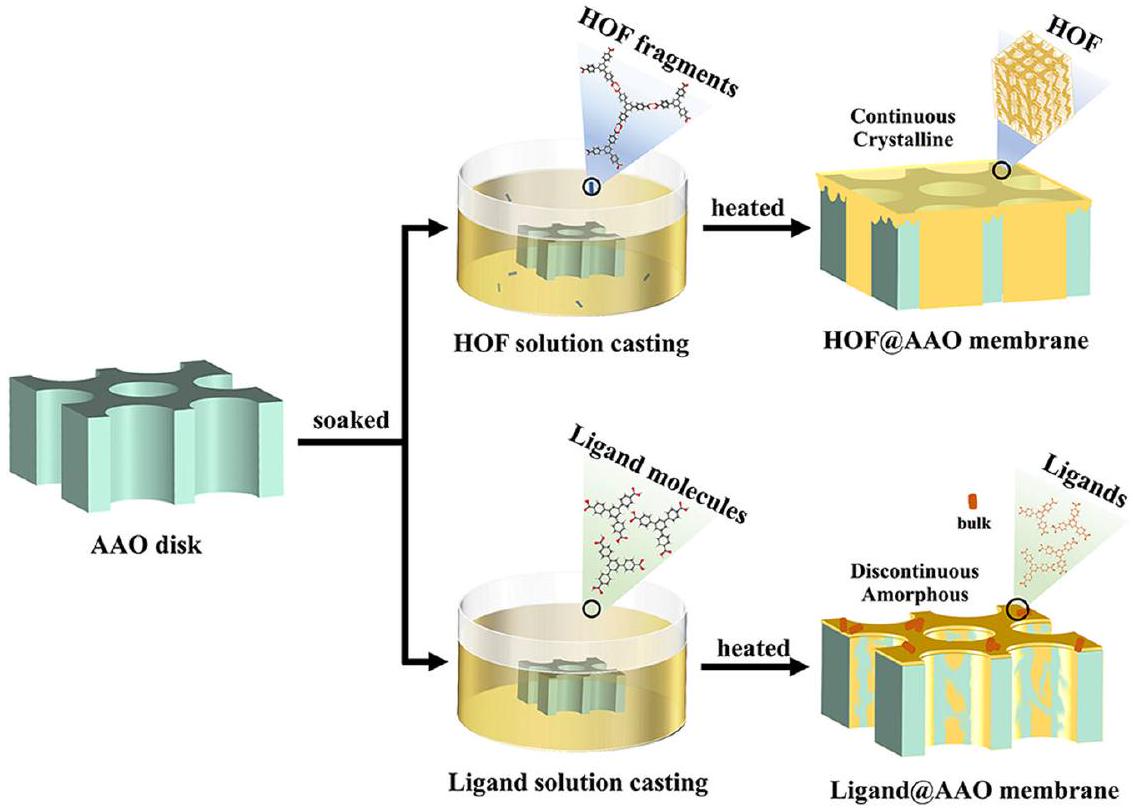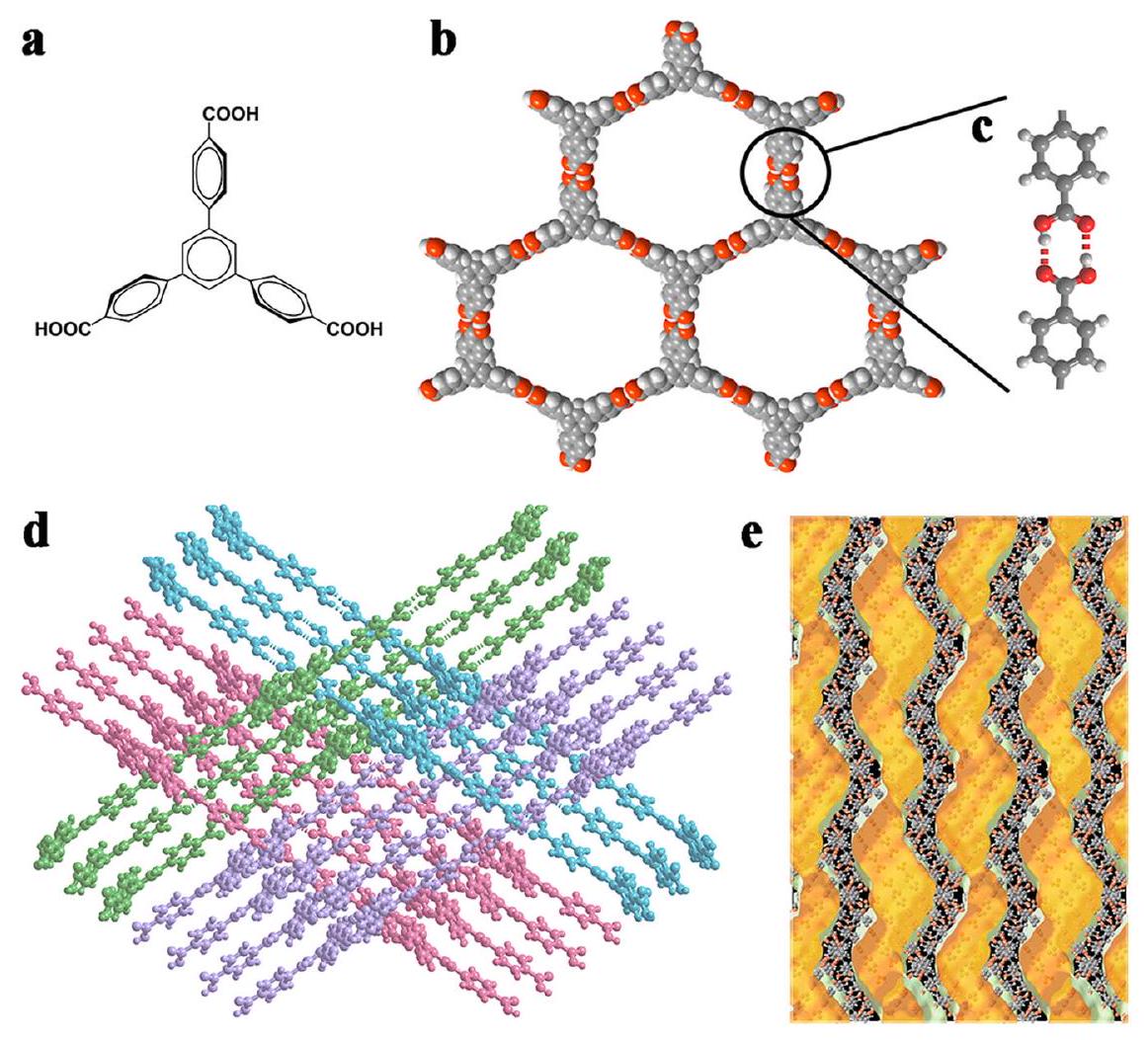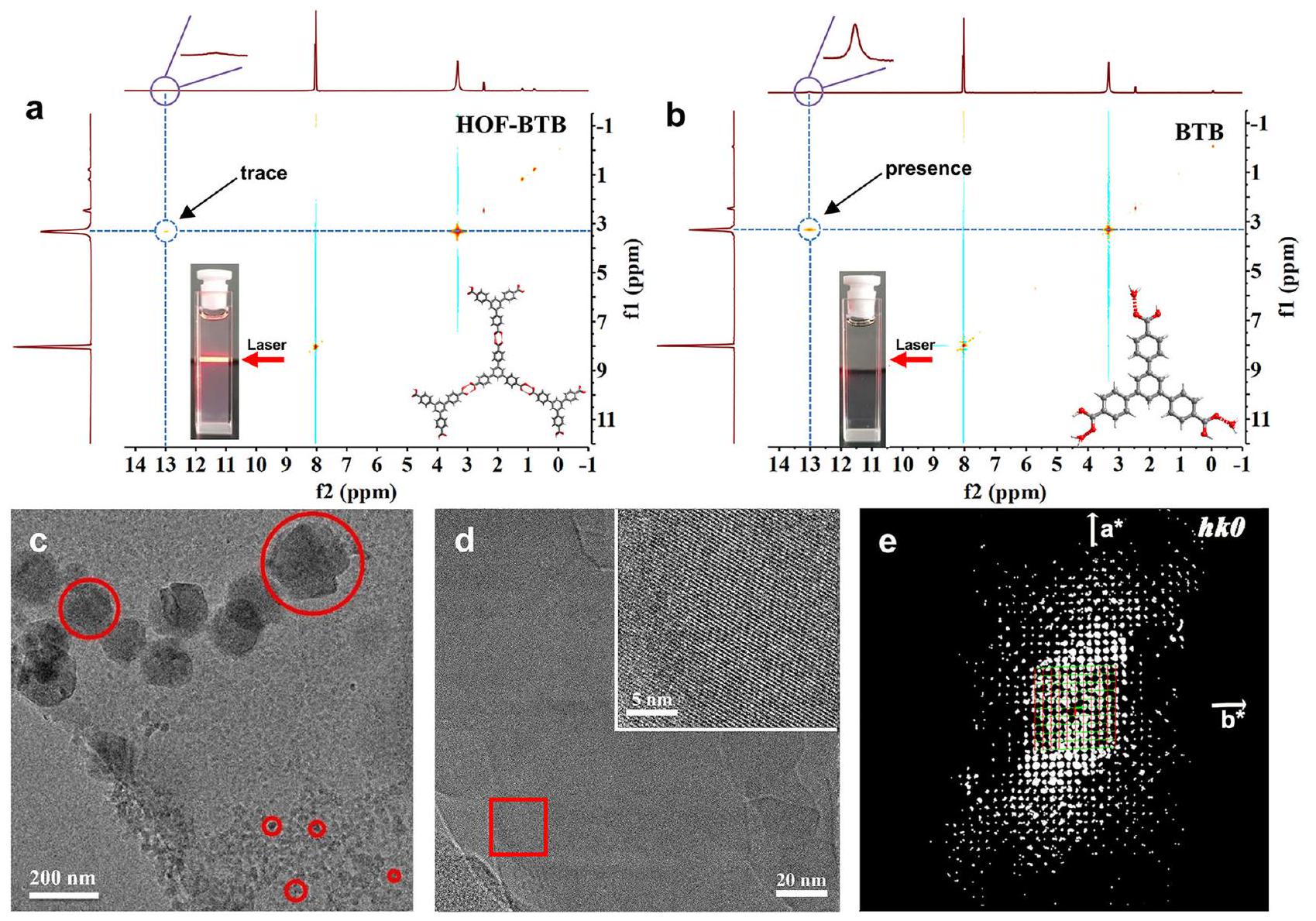DOI: https://doi.org/10.1038/s41467-024-44921-z
PMID: https://pubmed.ncbi.nlm.nih.gov/38245504
تاريخ النشر: 2024-01-20
الأطر العضوية المرتبطة بالهيدروجين في المحلول تتيح أغشية مستمرة وعالية البلورية
تم القبول: 10 يناير 2024
نُشر على الإنترنت: 20 يناير 2024
(أ) التحقق من التحديثات
الملخص
الإطارات العضوية المرتبطة بالهيدروجين (HOFs) هي نوع من المواد المسامية الناشئة. في الوقت الحالي، تم إجراء القليل من الأبحاث حول حالتها في المحلول. تُظهر هذه الدراسة أن HOFs تتفتت إلى جزيئات صغيرة مع الحفاظ على تجميعاتها الأصلية عند تشتتها في المذيبات، كما تم تأكيده بواسطة المجهر الإلكتروني بالتبريد المدمج مع تقنية حيود الإلكترون ثلاثي الأبعاد. تشير تحليلات الرنين المغناطيسي النووي (NMR) من البعد الواحد والبعدين وتحليلات جهد زتا إلى أن محلول الكولود المستند إلى HOF والمحلول الجزيئي المعزول لهما اختلافات كبيرة في التفاعلات بين الجزيئات وسلوك التجميع. تتيح هذه القابلية الفريدة للمعالجة في المحلول تصنيع أغشية HOF مستمرة ومتنوعة ذات بلورية عالية ومسامية من خلال طريقة صب المحلول على ركائز متنوعة. من بينها، تُظهر أغشية HOF-BTB@AAO أداءً عاليًا.
عملية الحل
النتائج
حل (الشكل التوضيحي الإضافي 5). سبب محتمل هو أن القوة


عمليات التجميع، في حين أن العدد المفرط من دورات الصب قد يؤدي إلى ذوبان جزئي لـ HOF-BTB المتبلور، مما ينتج عنه المزيد من العيوب في طبقة الطلاء وقناة AAO. أظهرت صور SEM المقطعية أنه مقارنةً بقرص AAO العاري، فإن HOF-BTB@AAO أظهر تباينًا أقل بين سطح القناة والمقطع العرضي لجدار AAO. وجود المكونات العضوية سيعيد انتشار المزيد من الإلكترونات ويظهر بشكل أكثر سطوعًا من AAO العاري (الشكل 4 أ، ب). علاوة على ذلك، أظهر رسم SEM-EDS محتوى كربون أعلى بكثير ومحتوى ألومنيوم أقل في HOF-BTB@AAO مقارنةً بقرص AAO (الجدول التكميلي 3)، مما يؤكد نجاح عملية الصب. بالإضافة إلى ذلك، في طيف FTIR لغشاء HOF-BTB@AAO، ظهرت الأطياف المميزة لـ BTB عند

(ب) في DMF. ج، د صور مجهر إلكتروني نقل بالتبريد (Cryo-EM) لـ


غشاء إطار الإيميدازولات-8 (مربع)، أغشية المصفوفة المختلطة (دائري)، أغشية النقل المساعد (مثلث)، وأغشية البوليمرات (خماسي). ج. المتانة على المدى الطويل لغشاء HOF-BTB@AAO من أجل
التجربة طويلة الأمد التي استمرت 44 ساعة (الشكل 5ج). أظهرت تحليلات الاعتماد على درجة الحرارة لنفاذية كل من
نقاش
توفر البيانات
References
- Sanders, D. F. et al. Energy-efficient polymeric gas separation membranes for a sustainable future: a review. Polymer 54, 4729-4761 (2013).
- Koros, W. J. & Zhang, C. Materials for next-generation molecularly selective synthetic membranes. Nat. Mater. 16, 289-297 (2017).
- Yang, X. et al. Wet-adhesive on-skin sensors based on metal-organic frameworks for wireless monitoring of metabolites in sweat. Adv. Mater. 34, 2201768 (2022).
- Carreon, M. A. Porous crystals as membranes. Science 367, 624-625 (2020).
- Little, M. A. & Cooper, A. I. The chemistry of porous organic molecular materials. Adv. Funct. Mater. 30, 1909842 (2020).
- Kang, Z. et al. Scalable crystalline porous membranes: current state and perspectives. Chem. Soc. Rev. 50, 1913-1944 (2021).
- Qiu, S., Xue, M. & Zhu, G. Metal-organic framework membranes: from synthesis to separation application. Chem. Soc. Rev. 43, 6116-6140 (2014).
- Denny, M. S., Moreton, J. C., Benz, L. & Cohen, S. M. Metal-organic frameworks for membrane-based separations. Nat. Rev. Mat. 1, 16078 (2016).
- Yuan, S. et al. Covalent organic frameworks for membrane separation. Chem. Soc. Rev. 48, 2665-2681 (2019).
- Yi-Fei, H., Ying-Xue, Y. & Hong-Bo, W. Porous hydrogen-bonded organic frameworks. Molecules 22, 266 (2017).
- Di Nunzio, M. R., Hisaki, I. & Douhal, A. HOFs under light: relevance to photon-based science and applications. J. Photochem. Photobiol., C 47, 100418 (2021).
- Sun, J., Liu, H. X. & Liu, T. F. Synthesis, crystal structure and characterization of a new hydrogen-bonded organic framework. Chin. J. Struct. Chem. 40, 1082-1087 (2021).
- Lin, R.-B. & Chen, B. Hydrogen-bonded organic frameworks: chemistry and functions. Chem. 8, 2114-2135 (2022).
- Song, X. et al. Design rules of hydrogen-bonded organic frameworks with high chemical and thermal stabilities. J. Am. Chem. Soc. 144, 10663-10687 (2022).
- Zhang, Z., Ye, Y., Xiang, S. & Chen, B. Exploring multifunctional hydrogen-bonded organic framework materials. Acc. Chem. Res. 55, 3752-3766 (2022).
- Li, J. R., Kuppler, R. J. & Zhou, H. C. Selective gas adsorption and separation in metal-organic frameworks. Chem. Soc. Rev. 38, 1477-1504 (2009).
- Zentner, C. A. et al. High surface area and
in a thermally stable 8-fold polycatenated hydrogen-bonded framework. Chem. Commun. 51, 11642-11645 (2015). - Li, Y.-L. et al. Record complexity in the polycatenation of three porous hydrogen-bonded organic frameworks with stepwise adsorption behaviors. J. Am. Chem. Soc. 142, 7218-7224 (2020).
- Kumar, A. & Dixit, C. K. Methods for characterization of nanoparticles. In Advances in Nanomedicine for the Delivery of Therapeutic Nucleic Acids, 43-58 (2017).
- Bain, A. D. Chemical exchange in NMR. Prog. Nucl. Magn. Reson. Spectrosc. 43, 63-103 (2003).
- Hu, X. J. et al. An easy and low-cost method of embedding chiral molecules in metal-organic frameworks for enantioseparation. Chem. Commun. 56, 7459-7462 (2020).
- Kaplan, J. Exchange broadening in nuclear magnetic resonance. J. Chem. Phys. 28, 278-282 (1958).
- Lankhorst, D., Schriever, J. & Leyte, J. C. An NMR relaxation study of hydrogen exchange and its deuterium isotope effects in aqueous carboxylic acid solutions. Chem. Phys. 77, 319-340 (1983).
- Feng, S. et al. Fabrication of a hydrogen-bonded organic framework membrane through solution processing for pressure-regulated gas separation. Angew. Chem. Int. Ed. 59, 3840-3845 (2020).
- Devic, T., Serre, C., Audebrand, N., Marrot, J. & Ferey, G. MIL-103, a 3-D lanthanide-based metal organic framework with large onedimensional tunnels and a high surface area. J. Am. Chem. Soc. 127, 12788-12789 (2005).
- Qi, Y. et al. An ultra-robust and crystalline redeemable hydrogenbonded organic framework for synergistic chemo-photodynamic therapy. Angew. Chem. Int. Ed. 130, 7817-7822 (2018).
- Ying, Y., Peh, S. B., Yang, H., Yang, Z. & Zhao, D. Ultrathin covalent organic framework membranes via a multi-interfacial engineering strategy for gas separation. Adv. Mater. 34, e2104946 (2022).
- Hongwei, F. et al. COF-COF bilayer membranes for highly selective gas. Separation. J. Am. Chem. Soc. 140, 10094-10098 (2018).
- An, H., Park, S., Kwon, H. T., Jeong, H.-K. & Lee, J. S. A new superior competitor for exceptional propylene/propane separations: ZIF-67 containing mixed matrix membranes. J. Membr. Sci. 526, 367-376 (2017).
الشكر
مساهمات المؤلفين
المصالح المتنافسة
معلومات إضافية
المواد التكميلية المتاحة على https://doi.org/10.1038/s41467-024-44921-z.
© المؤلفون 2024
المختبر الوطني الرئيسي للكيمياء الهيكلية، معهد فوجيان للبحث في هيكل المادة، الأكاديمية الصينية للعلوم، 350002 فوزهو، فوجيان، جمهورية الصين الشعبية. جامعة الأكاديمية الصينية للعلوم، 100049 طريق يوكوان، منطقة شيتشينغشان، بكين، جمهورية الصين الشعبية. قسم الكيمياء، كلية العلوم، جامعة تربيات مدرس، صندوق بريد 14115-175 طهران، إيران. ساهم هؤلاء المؤلفون بالتساوي: تشي يين، كوان بانغ. البريد الإلكتروني: tfliu@fjirsm.ac.cn
DOI: https://doi.org/10.1038/s41467-024-44921-z
PMID: https://pubmed.ncbi.nlm.nih.gov/38245504
Publication Date: 2024-01-20
Hydrogen-bonded organic frameworks in solution enables continuous and highcrystalline membranes
Accepted: 10 January 2024
Published online: 20 January 2024
(A) Check for updates
Abstract
Hydrogen-Bonded organic frameworks (HOFs) are a type of emerging porous materials. At present, little research has been conducted on their solution state. This work demonstrates that HOFs fragment into small particles while maintaining their original assemblies upon dispersing in solvents, as confirmed by Cryo-electron microscopy coupled with 3D electron diffraction technology. 1D and 2D-Nuclear Magnetic Resonance (NMR) and zeta potential analyses indicate the HOF-based colloid solution and the isolated molecular solution have significant differences in intermolecular interactions and aggregation behavior. Such unique solution processibility allows for fabricating diverse continuous HOF membranes with high crystallinity and porosity through solution-casting approach on various substrates. Among them, HOF-BTB@AAO membranes show high
of solution processability
Results
solution (Supplementary Fig. 5). A plausible reason is that the strong


assembling processes, whereas excessive number of casting cycles would lead to partial dissolution of the crystallized HOF-BTB, resulting in more defects in the coating layer and AAO channel. The crosssectional SEM images showed that compared with the bare AAO disk, HOF-BTB@AAO exhibited a lower contrast between the channel surface and the cross section of the AAO wall. The presence of organic components would backscatter more electrons and appear brighter than the bare AAO (Fig. 4a, b insets). Furthermore, SEM-EDS mapping showed a much higher C content and lower Al content in HOFBTB@AAO than that in the AAO disk (Supplementary Table 3), conforming the success of the casting process. Besides, in the Fourier Transform Infrared (FTIR) spectrum of HOF-BTB@AAO membrane, the appearance of BTB’s characteristic bands at

(b inset) in DMF. c, d Cryo-transmission electron microscopy (Cryo-EM) images of


Imidazolate Framework-8 membranes (square), mixed matrix membranes (rotundity), Facilitated Transport Membranes (triangle), and polymers membranes (pentagon). c Long-term durability of HOF-BTB@AAO membrane for
long-term experiment of 44 h (Fig. 5c). The analyses of temperature dependence to the permeances of both
Discussion
Data availability
References
- Sanders, D. F. et al. Energy-efficient polymeric gas separation membranes for a sustainable future: a review. Polymer 54, 4729-4761 (2013).
- Koros, W. J. & Zhang, C. Materials for next-generation molecularly selective synthetic membranes. Nat. Mater. 16, 289-297 (2017).
- Yang, X. et al. Wet-adhesive on-skin sensors based on metal-organic frameworks for wireless monitoring of metabolites in sweat. Adv. Mater. 34, 2201768 (2022).
- Carreon, M. A. Porous crystals as membranes. Science 367, 624-625 (2020).
- Little, M. A. & Cooper, A. I. The chemistry of porous organic molecular materials. Adv. Funct. Mater. 30, 1909842 (2020).
- Kang, Z. et al. Scalable crystalline porous membranes: current state and perspectives. Chem. Soc. Rev. 50, 1913-1944 (2021).
- Qiu, S., Xue, M. & Zhu, G. Metal-organic framework membranes: from synthesis to separation application. Chem. Soc. Rev. 43, 6116-6140 (2014).
- Denny, M. S., Moreton, J. C., Benz, L. & Cohen, S. M. Metal-organic frameworks for membrane-based separations. Nat. Rev. Mat. 1, 16078 (2016).
- Yuan, S. et al. Covalent organic frameworks for membrane separation. Chem. Soc. Rev. 48, 2665-2681 (2019).
- Yi-Fei, H., Ying-Xue, Y. & Hong-Bo, W. Porous hydrogen-bonded organic frameworks. Molecules 22, 266 (2017).
- Di Nunzio, M. R., Hisaki, I. & Douhal, A. HOFs under light: relevance to photon-based science and applications. J. Photochem. Photobiol., C 47, 100418 (2021).
- Sun, J., Liu, H. X. & Liu, T. F. Synthesis, crystal structure and characterization of a new hydrogen-bonded organic framework. Chin. J. Struct. Chem. 40, 1082-1087 (2021).
- Lin, R.-B. & Chen, B. Hydrogen-bonded organic frameworks: chemistry and functions. Chem. 8, 2114-2135 (2022).
- Song, X. et al. Design rules of hydrogen-bonded organic frameworks with high chemical and thermal stabilities. J. Am. Chem. Soc. 144, 10663-10687 (2022).
- Zhang, Z., Ye, Y., Xiang, S. & Chen, B. Exploring multifunctional hydrogen-bonded organic framework materials. Acc. Chem. Res. 55, 3752-3766 (2022).
- Li, J. R., Kuppler, R. J. & Zhou, H. C. Selective gas adsorption and separation in metal-organic frameworks. Chem. Soc. Rev. 38, 1477-1504 (2009).
- Zentner, C. A. et al. High surface area and
in a thermally stable 8-fold polycatenated hydrogen-bonded framework. Chem. Commun. 51, 11642-11645 (2015). - Li, Y.-L. et al. Record complexity in the polycatenation of three porous hydrogen-bonded organic frameworks with stepwise adsorption behaviors. J. Am. Chem. Soc. 142, 7218-7224 (2020).
- Kumar, A. & Dixit, C. K. Methods for characterization of nanoparticles. In Advances in Nanomedicine for the Delivery of Therapeutic Nucleic Acids, 43-58 (2017).
- Bain, A. D. Chemical exchange in NMR. Prog. Nucl. Magn. Reson. Spectrosc. 43, 63-103 (2003).
- Hu, X. J. et al. An easy and low-cost method of embedding chiral molecules in metal-organic frameworks for enantioseparation. Chem. Commun. 56, 7459-7462 (2020).
- Kaplan, J. Exchange broadening in nuclear magnetic resonance. J. Chem. Phys. 28, 278-282 (1958).
- Lankhorst, D., Schriever, J. & Leyte, J. C. An NMR relaxation study of hydrogen exchange and its deuterium isotope effects in aqueous carboxylic acid solutions. Chem. Phys. 77, 319-340 (1983).
- Feng, S. et al. Fabrication of a hydrogen-bonded organic framework membrane through solution processing for pressure-regulated gas separation. Angew. Chem. Int. Ed. 59, 3840-3845 (2020).
- Devic, T., Serre, C., Audebrand, N., Marrot, J. & Ferey, G. MIL-103, a 3-D lanthanide-based metal organic framework with large onedimensional tunnels and a high surface area. J. Am. Chem. Soc. 127, 12788-12789 (2005).
- Qi, Y. et al. An ultra-robust and crystalline redeemable hydrogenbonded organic framework for synergistic chemo-photodynamic therapy. Angew. Chem. Int. Ed. 130, 7817-7822 (2018).
- Ying, Y., Peh, S. B., Yang, H., Yang, Z. & Zhao, D. Ultrathin covalent organic framework membranes via a multi-interfacial engineering strategy for gas separation. Adv. Mater. 34, e2104946 (2022).
- Hongwei, F. et al. COF-COF bilayer membranes for highly selective gas. Separation. J. Am. Chem. Soc. 140, 10094-10098 (2018).
- An, H., Park, S., Kwon, H. T., Jeong, H.-K. & Lee, J. S. A new superior competitor for exceptional propylene/propane separations: ZIF-67 containing mixed matrix membranes. J. Membr. Sci. 526, 367-376 (2017).
Acknowledgements
Author contributions
Competing interests
Additional information
supplementary material available at https://doi.org/10.1038/s41467-024-44921-z.
© The Author(s) 2024
State Key Laboratory of Structural Chemistry, Fujian Institute of Research on the Structure of Matter, Chinese Academy of Sciences, 350002 Fuzhou, Fujian, P. R. China. University of Chinese Academy of Sciences, 100049Yuquan Road, Shijingshan District, Beijing, P. R. China. Department of Chemistry, Faculty of Sciences, Tarbiat Modares University, P.O. Box 14115-175 Tehran, Iran. These authors contributed equally: Qi Yin, Kuan Pang. e-mail: tfliu@fjirsm.ac.cn
